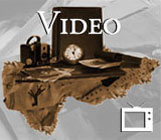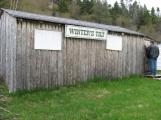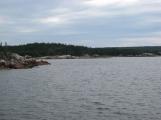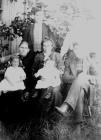1
In local tradition told in Birchy Bay, the first settler to the area was William Canning who moved here in the early 1800's. He was a fisherman and like many fisherman of those days he fished seasonally on the coast of Labrador. He built a small tilt on Canning's Island and lived there with his wife. While he was gone on a fishing expedition, his wife would stay in the tilt during the summer tending to the gardens and livestock to ensure there was sufficient food for the winter months.One fall, William returned with a load of supplies which he had bought from his summer wages. The fish had been plentiful that year. He was excited that he would soon see his beloved wife and show her all the things that he purchased. When he reached the bay, there was no smoke coming from the tilt. There was only rubble in place where the tilt stood. His wife did not run out to greet him. With a terrible dread, he landed on the beach and surveyed the area. Here he found his home burned to the ground. His vegetable gardens were grown up with weeds. There were no sounds of his well cared for livestock. With a closer look he found the mutilated body of his wife who was pregnant with child. In grief, he buried the remains of his wife on the Island. Has the story goes, he then went with his load of supplies and rowed with aid of a sail to Englee. There he settled and remarried leaving the nightmare he encountered in Birchy Bay far behind.
It has been said that the native Beothuk had burned down his tilt and killed his wife. This is one of the very few records of Beothuk hostilities against a woman .
2
William Canning and the BeothukFall 2007
Birchy Bay, Newfoundland & Labrador, Canada
 Credits:
Credits:John Canning
4
Birchy Bay Census 1857Number of habitants
6
Number of males under ten years of age
2
Number of males from 10-20
1
Number of Females from 20-30
1
Number of males 50-70
1
Number of Females 50-70
1
Number of Married persons
Male-1
female-2
Birth Place- All were from Newfoundland
Denomination-Church of England (Anglican)
Profession-2 persons engaged in catching fish
1 person- able bodied seamen and fisherman in this colony and its dependencies
There was one inhabited House
There were four nets and seines
Half of the salmon caught and cured
½ an acre of dyke and other improved lands of average value.
80 barrels of potatoes raised
5 swine and goats
1 crippled aged and disabled paupers
6
Canning's Island was an ideal home for the first family of Birchy Bay. According to records and local folklore, Andrew Canning Sr. with his family settled next. His brother was the ill fated William Canning, who in grief moved to Englee. Andrew was from Barr`d Islands like his brother and had been a planter there in 1836.His reason may have been as good as any to locate in the bay. It appears that the local merchants on Barr'd islands employed the Canning family in the salmon fishery. So the Canning family had the rights of procuring salmon from the surrounding area of Jumpers brook. In the 1857 census which is believe to be that of the Canning family they are recorded to be salmon fisherman. No doubt exploiting the resources of Jumpers brook which was known to have been a breeding place for Salmon.
8
From the 1857 general census it shows that the Canning family were still living here in the "bay" year round. The young men, interested in making more money may have went to Barr'd Islands to participate in the cod fishery. But Andrew Sr. stayed in Birchy Bay with his wife who was disabled , and his son Joseph who would have been 18 in 1857. Andrew Jr.`s wife, Mary Mercer, and their two children lived with them.The family was self-sufficient in food. From this we can see that the family here was quite settled in the bay.9
The first child known to have been born in Birchy Bay was Joseph Canning. He would have been born on Canning Island. Joseph would spend much of his time growing up in Birchy Bay with excursions to Barr'd island to get supplies and to visit family. He would marry two times and move between Western Head and Comfort Cove. He also went blind is his elder years and returned to Birchy Bay to live with his son Jeremiah. It is believed that he died here at an old age.10
According to local folklore, the last winter that Andrew Canning Sr. and his family stayed here he was struck by tragedy. His son Andrew Jr., had been overtaken with some sort of illness. They made different concoctions to try and nurture him back to health. But all attempts were futile. After a few days battle with this sickness Andrew Jr. took his last breath.His family prepared his body for burial and buried him beneath a bald outcropping of granite in the soil found on a narrow bar that led to a smaller division on Canning Island. This according to tradition this was the last winter spent in the bay by Andrew Sr. His family relocated again to Barr'd Islands and Andrew Jr.'s son, John, was placed in the care of Levi Witcher a man who himself could not have children and was a close friend to Johns father.
11
Birchy Bay remained uninhabited for about twenty years after 1857. However census records indicate that there were still people living here. Folklore indicates that the first man to trap in Birchy Bay was John Canning of Newstead. This man had a trap line which led from the side of Jumpers brook far inland to Jumpers pond. He trapped here for many years.In the 1921 Census of Newstead and in other records that there were Cannings' born while living in the Bay up to 1871. John Canning of Newstead was the father of these children. He was married first to Maria Wall who died at an early ages. Later he remarried to Elizabeth Cull. It can be assumed that this John Canning who was also from Barr`d Island held a link with Andrew Canning Sr. It is very possible that this John Canning was the son of Andrew Canning Sr. This would make Andrew Jr. and Joseph Canning his brothers.
13
The Canning FamilyVideo done in 2008
Birchy Bay, Newfoundland & Labrador, Canada
 Credits:
Credits:Desmond Canning



